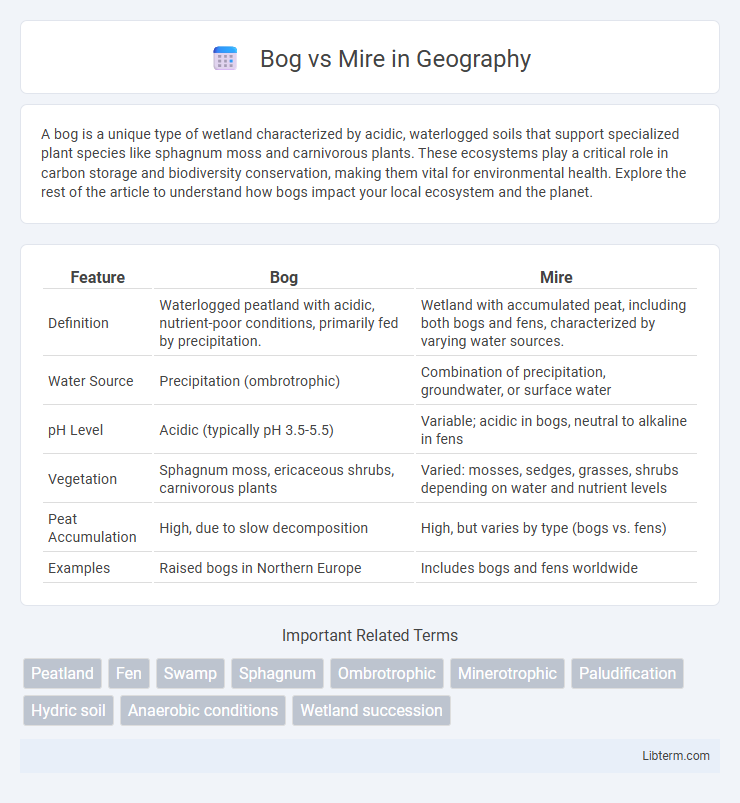A bog is a unique type of wetland characterized by acidic, waterlogged soils that support specialized plant species like sphagnum moss and carnivorous plants. These ecosystems play a critical role in carbon storage and biodiversity conservation, making them vital for environmental health. Explore the rest of the article to understand how bogs impact your local ecosystem and the planet.
Table of Comparison
| Feature | Bog | Mire |
|---|---|---|
| Definition | Waterlogged peatland with acidic, nutrient-poor conditions, primarily fed by precipitation. | Wetland with accumulated peat, including both bogs and fens, characterized by varying water sources. |
| Water Source | Precipitation (ombrotrophic) | Combination of precipitation, groundwater, or surface water |
| pH Level | Acidic (typically pH 3.5-5.5) | Variable; acidic in bogs, neutral to alkaline in fens |
| Vegetation | Sphagnum moss, ericaceous shrubs, carnivorous plants | Varied: mosses, sedges, grasses, shrubs depending on water and nutrient levels |
| Peat Accumulation | High, due to slow decomposition | High, but varies by type (bogs vs. fens) |
| Examples | Raised bogs in Northern Europe | Includes bogs and fens worldwide |
Introduction to Bogs and Mires
Bogs and mires are types of wetlands characterized by waterlogged conditions that support unique plant communities, primarily sphagnum mosses in bogs. Bogs typically accumulate peat from partially decomposed organic material in acidic, nutrient-poor environments, creating distinct ecosystems with specialized flora like carnivorous plants. Mires include a broader category of peat-forming wetlands, encompassing both bogs and fens, differing mainly in hydrology and nutrient availability.
Defining Bogs: Key Characteristics
Bogs are a type of wetland characterized by acidic, waterlogged conditions with low nutrient availability, primarily fed by precipitation rather than groundwater. They support unique vegetation such as sphagnum mosses, ericaceous shrubs, and carnivorous plants adapted to nutrient-poor environments. Unlike mires, bogs accumulate peat layers that form slowly due to the slow decomposition rates caused by anaerobic and acidic conditions.
Defining Mires: Types and Features
Mires are wetland ecosystems characterized by peat accumulation formed through slow plant decomposition in waterlogged conditions, encompassing two primary types: bogs and fens. Bogs are ombrotrophic mires fed exclusively by precipitation, resulting in acidic, nutrient-poor environments dominated by sphagnum mosses. In contrast, fens receive mineral-rich groundwater inputs, supporting higher biodiversity and a neutral to alkaline pH, often featuring sedges and brown mosses alongside peat accumulation.
Formation Processes: Bogs vs Mires
Bogs form primarily through the accumulation of sphagnum moss in cool, wet climates, resulting in acidic, nutrient-poor conditions that slow decomposition. Mires are broader peatland ecosystems that develop from the gradual accumulation of organic matter in waterlogged environments, including both bogs and fens, with varied hydrology influencing peat formation. The key difference lies in bogs being ombrotrophic, relying solely on precipitation, whereas mires encompass both ombrotrophic and minerotrophic systems where groundwater also contributes.
Hydrology and Water Sources
Bogs primarily receive water from precipitation, leading to acidic and nutrient-poor conditions due to limited mineral input. Mires encompass both bogs and fens, but unlike bogs, fens obtain water from groundwater and surface runoff, resulting in higher nutrient availability and less acidity. Hydrologically, bogs are ombrotrophic systems, relying solely on rainwater, while mires consist of a continuum of hydrological inputs influencing their water chemistry and ecological characteristics.
Vegetation and Biodiversity Comparison
Bogs typically support sphagnum mosses, ericaceous shrubs, and stunted trees, creating acidic, nutrient-poor conditions that favor specialized plant species and a unique assemblage of biodiversity. Mires, encompassing both bogs and fens, exhibit more diverse vegetation including sedges, grasses, and a wider range of hydrophilic plants, contributing to higher overall biodiversity. The contrast in vegetation directly influences habitat complexity and species richness, with mires generally hosting a broader spectrum of flora and fauna than bogs due to variation in water chemistry and nutrient availability.
Soil Composition and Peat Accumulation
Bogs are characterized by acidic, nutrient-poor soils composed mainly of sphagnum moss and partially decomposed organic matter, resulting in slow peat accumulation. Mires encompass both bogs and fens, exhibiting a wider range of soil compositions from acidic to more minerotrophic conditions, which influence the rate and quality of peat formation. Peat in bogs accumulates primarily through anaerobic conditions that inhibit decomposition, whereas mires show variable peat accumulation rates depending on hydrology and nutrient availability.
Ecological Roles and Significance
Bogs serve as carbon sinks, storing large amounts of organic carbon and regulating global climate by slowing decomposition due to acidic, waterlogged conditions. Mires, encompassing both bogs and fens, support unique biodiversity by providing specialized habitats for rare plant and animal species adapted to saturated, nutrient-poor soils. Their ecological roles include water filtration, flood mitigation, and maintaining hydrological balance in surrounding ecosystems.
Human Impacts and Conservation
Bogs and mires, critical wetland ecosystems, face significant threats from human activities such as peat extraction, agriculture, and urban development, causing habitat degradation and carbon release. Conservation efforts prioritize protecting these areas through legal protections, restoration projects, and sustainable land management to maintain biodiversity and carbon sequestration functions. Effective conservation strategies also involve community engagement and scientific monitoring to balance ecological preservation with socio-economic needs.
Key Differences Between Bogs and Mires
Bogs are a type of mire characterized by their acidic, nutrient-poor conditions and are primarily fed by precipitation rather than groundwater, leading to the accumulation of peat composed mostly of sphagnum moss. Mires broadly include both bogs and fens, but unlike bogs, fens receive nutrients from groundwater, resulting in higher biodiversity and less acidity. The key difference lies in their hydrology and nutrient sources, with bogs being ombrotrophic and mires including minerotrophic systems.
Bog Infographic

 libterm.com
libterm.com